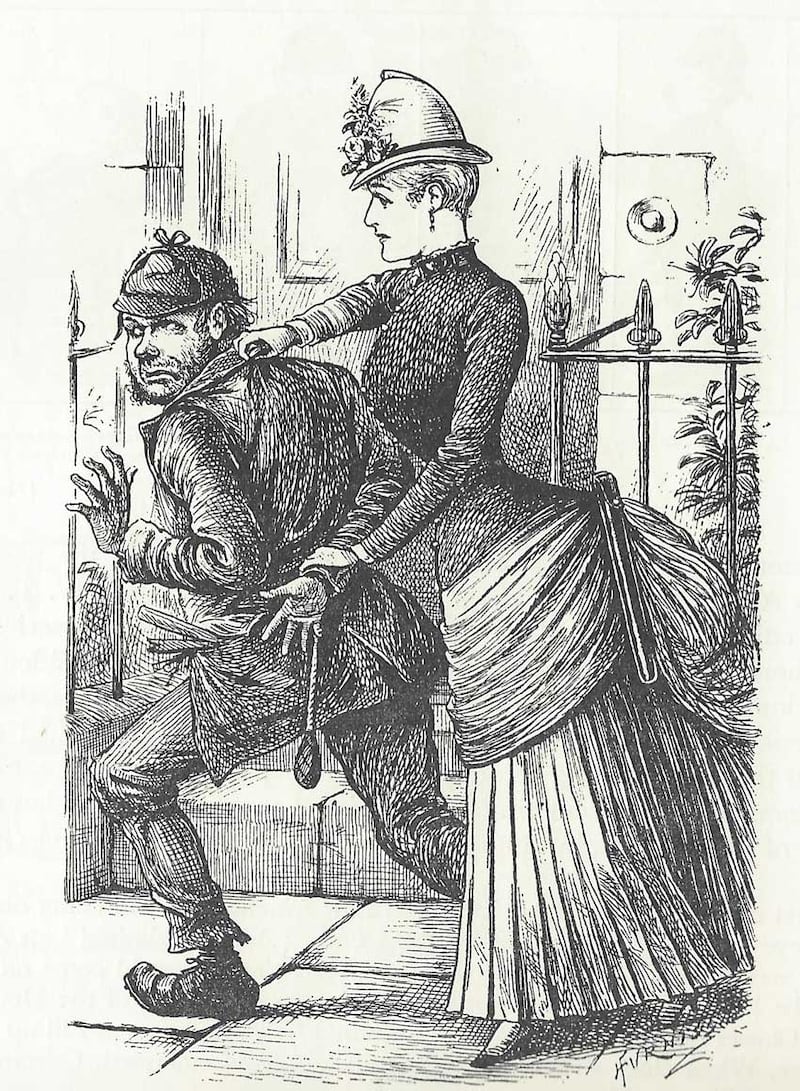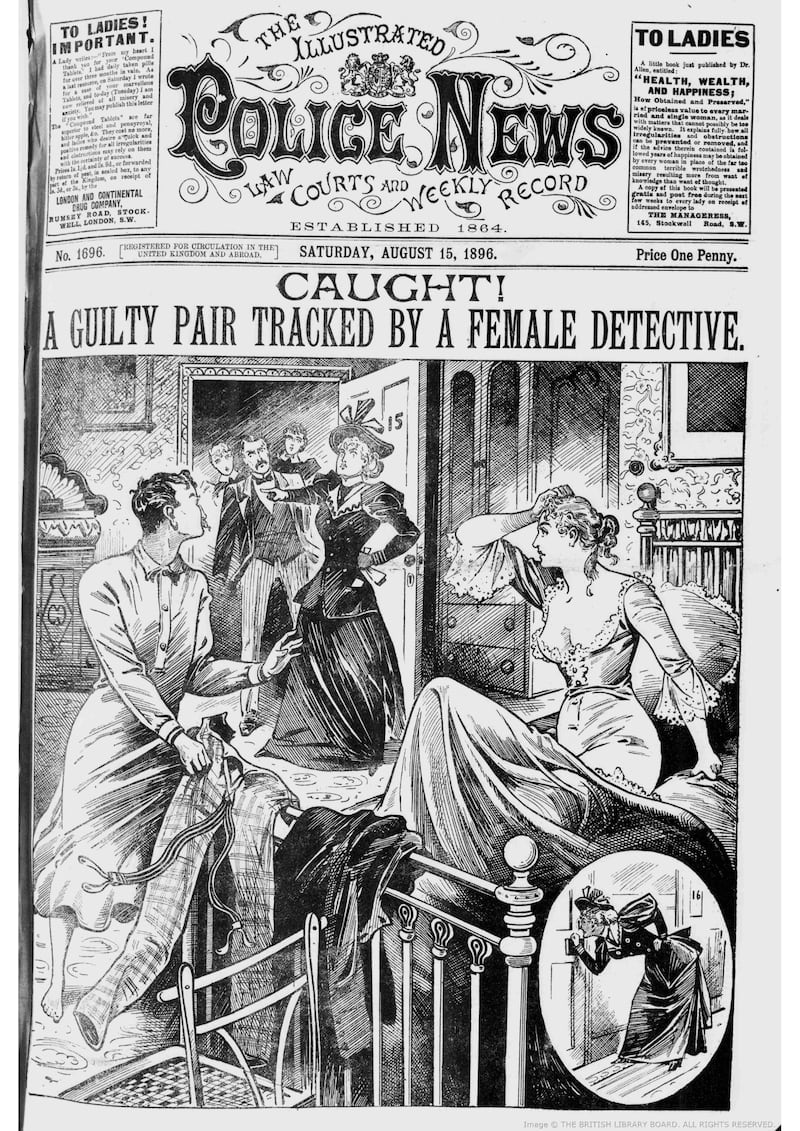Readers may be familiar with the fiery Victorian detective heroine Eliza Scarlet in the Irish-made TV series Miss Scarlet and the Duke. Set in 1880s London but filmed in Dublin, the series made by production company ShinAwil stars Irish actors including Evan McCabe and Roisín Murphy.
It might, though, be a surprise to learn that there really were women detectives working the streets, ports, and post offices of Victorian Ireland. In 2012, I began a project to uncover the lives of women in the 19th century who worked with the police and with “private enquiry agencies” (often run by former policemen) to pursue information that others preferred to keep secret. I studied small ads in 19th-century newspapers, court reports and police archives. It revealed a new world to me. A world where women were assisting the police force in nabbing everyone from burglars to embezzlers, counterfeiters to rogue mystics. A world in which ordinary Victorians were using “private enquiry agents” to fight off blackmailers, trace missing people and gain evidence of adultery to obtain a divorce.
Women, I discovered, were key to Victorian detective services. They could shadow suspects and infiltrate properties unnoticed, posing as a servant, lodger, or confidential friend. They were also able to search women’s bodies and clothing for stolen and concealed items and to access spaces, from backstreet abortionists to fortunetelling circles, where men could not go.

Real-life Victorian women sleuths were not always on the side of the angels, or of their fellow women. But they played an important role in breaking cases that brought skulduggery to light. Fanny Hodson, wife of a British army chaplain, went undercover to investigate “baby farmers”: women who “took care of” illegitimate children immediately after birth, or advertised that they would give a loving home to infants whose mothers could not look after them, but who subsequently died of neglect. Hodson believed that baby farmers were contract killers, profiting from the shame and stigma associated with illegitimate births and the desperation of women unable to care for their children. Pretending to be unhappily pregnant herself and in need of a baby farmer’s services, Hodson got into houses where she suspected that child abuse was occurring and worked with the police to prosecute offenders.
READ MORE
On the Victorian stage, the woman detective became a gun-toting, fist-swinging action heroine in theatres where she appeared before audiences of up to 4,000 people every night. The scourge of dastardly men who tried to steal women’s inheritances and lock them in lunatic asylums, she was the Jennifer Lawrence of her day: a woman who could shape-shift and kick ass, dealing out the retribution that love rats and domestic abusers so richly deserved.
In 1868, the play The Female Detective came to the Queen’s Theatre Dublin, with Lizzie Willmore in the starring role. The play was based on a horrific Irish case from 1819 where John Scanlan, a gentleman from Co Limerick, was arrested for the murder of 15-year-old Ellen Hanley, the daughter of a local farmer and a noted beauty. The two had eloped, but when Scanlan tired of Hanley, he arranged a hit: his boatman took her out in his boat, clubbed her to death with his musket and bound and drowned her in a lake. The case had already been immortalised in Gerald Griffin’s The Collegians and Dion Boucicault’s The Colleen Bawn. In The Female Detective, when the villain drowns his wife in the lake, it is the feisty woman investigator who catches up with him, preventing him from marrying his wife’s sister, stealing her money, and perpetuating a grim cycle of domestic violence. Twenty years before Sherlock Holmes first appeared in print, the woman detective was the fantasy figure who helped women get even.
In reality, of course, the life of the Victorian woman detective was considerably less glamorous, and often more morally ambiguous. Women might be employed by either side of a warring couple to spy on the sexual shenanigans of the unloved spouse. They were sometimes tasked with arranging a seduction, so that adultery could be “proven” and a cheap divorce secured. “Election watching” was also commonplace, with petticoated PIs seeking to dig dirt on political opponents or gain private information about their campaigns.
The Spectator reported an interview with the head of a detective agency in 1893: “Among other curious statements made by the chief of this office was ... that at the general election of 1886 he had some 700 men scattered all over the country, ‘seeing that the work of organisation was being carried out properly, and watching both friends and opponents of the people who employed them.’ ‘I have been speaking all along of men,’ he says, ‘but you must not imagine that our staff consists only of men. As a matter of fact, we employ very few, except as managers or superintendents. Most of the members of the staff are women.’”

In Ireland, sensitivities about women detectives being employed for political surveillance naturally ran high. A “female detective spy” of “very captivating manners” caused a sensation in 1884 when she appeared in Dublin, staying at two of the principal hotels, and speaking “very patronisingly of dynamite and very warmly of the cause”. Irish nationalist MP Timothy Healy raised the matter in parliament in London with the home secretary William Harcourt, calling attention to the “presence of a female emissary from the home office in Ireland”. The newspapers named her as “Mrs Detective Tyler”. Harcourt denied any knowledge of the matter. Healy claimed that a telegram from the home office to this woman detective or spy was “in the possession of a friend of mine”.
At this time of acute tension between Irish Home Rulers and those who opposed Ireland’s political independence from Britain, rumour was rife and daggers drawn. The thought of Britain employing women detectives who might be agents provocateurs as part of a covert unionist operation, seducing Irish politicians into expression of treasonable sentiments with the intention of incriminating them, understandably provoked outrage among Irish MPs. It was reported in newspapers that women detectives had been involved in the capture of Fenian James Stephens in 1865; they had shadowed his wife until he broke cover. Female “detective searchers” working in customs at Irish ports also recovered weapons smuggled into Ireland from the United States. In 1888 under the arresting headline “Another Revolver in a Bustle” the newspapers announced that Catherine Murphy of Cork, a steerage passenger alighting from the Boston boat, had been caught with a gun and several rounds of ammunition in the fashionable flounces decorating the backside of her dress.

Sometimes, women were involved in unearthing political plots. In 1887, the Westminster Detective Agency investigated the case of the “Parnell Papers”, which appeared to implicate Irish MP Charles Stewart Parnell in the Phoenix Park murders: the assassination of two English officials in Dublin. These letters had been sold to the Times of London by former Fenian Richard Pigott. Women detectives reportedly shadowed Pigott, whose shocking forgery of the letters was eventually proven to be a botched character assassination attempt on Parnell, the culmination of a long vendetta.
The idea that women detectives might be involved in counter-terrorist surveillance was as exciting to Victorian audiences as it is to us now. Florence Marryat’s edge-of-seat thriller, In the Name of Liberty (1897), imagines a downtrodden wife, Jane Farrell, whose husband appears to have abandoned her, taking a job in the Criminal Investigation Department, where she is tasked with surveilling potential targets of an Irish bombing campaign. Farrell, in her counter-terrorist role, is posted in the riverside garden of the Earl of Innisfale’s mansion at night while a glittering party is in full swing.
The bomber appears … and turns out to be Farrell’s husband Maurice, who has joined a Fenian-anarchist b brotherhood. Farrell seizes the bomb and throws it into the goldfish pond, where it explodes (harmlessly to humans but fatally to the goldfish). However, she lets her husband go, concealing the bomber’s identity from her police colleagues. Marryat’s plot is electric. It dramatises the conflict in marriage as a battle between the woman detective and her terrorist husband. Serialised in the Belfast Weekly News, Marryat’s story drew attention to the volatile relationship between Ireland and Britain.
Real Victorian women investigators would likely have smiled ruefully at the sexual freedoms and the stunning wardrobe of TV’s Miss Scarlet. Many of them were working-class; many were mothers. Often they were employed on what we would now call “zero-hours contracts”, fitting their investigations around theatrical engagements, office work, or sewing. They encountered more squalor than glamour. Yet, from the dime novel and the melodrama, they would also have recognised the pull of the fantasy of female empowerment that the imagined woman detective embodied: the way that she wore the trousers (often literally), was able to pass as a man or to floor one. The Victorian female detective was peeping through the keyhole at a different future: one in which women would finally be given the right to determine their own lives, to go where they chose and know whatever they desired. Now that was a case worth pursuing.
The Mysterious Case of the Victorian Female Detective, by Sara Lodge, is published by Yale University Press. Lodge is senior lecturer in 19th-century literature and culture at the University of St Andrews, Scotland
- Sign up for push alerts and have the best news, analysis and comment delivered directly to your phone
- Join The Irish Times on WhatsApp and stay up to date
- Listen to our Inside Politics podcast for the best political chat and analysis


















